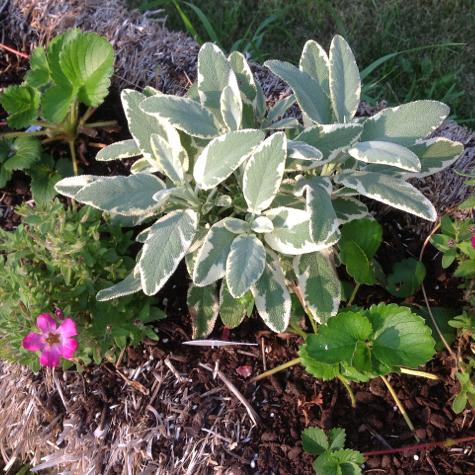Continuing our herbal theme from the last newsletter, this week, let's get to know some exotic herbs that we love to grow at Sage Garden!
Patchouli
Did you know that the mystical "hippie" aroma of the 1970s comes from a plant called Pogostemon cablins, aka patchouli (if that reference doesn't land, the "witch" scratch 'n sniff stickers from the 1980s were also patchouli-scented!)
Originally from India, this super-earthy herb grows beautifully in pots and can be harvested down in fall or even wintered indoors. The fresh or dried leaves are highly aromatic and used mostly for fragrance (creative chefs do sometimes put them to use in recipes too!). Patchouli is heat and humidity-loving, so if wintering indoors, plan for grow lights and use a pebble tray for humidity.
Broadleaf or Jamaican Thyme (Coleus amboinicus)
There are at least three distinct styles of this plant and we currently have the classic green leaf and the yellow variegated (plus the closely related Cuban oregano) available at the moment. The freshly-scented leaves are large, succulent and slightly fuzzy!
Although not very familiar as a culinary herb outside of the Caribbean, this plant is definitely an amazing seasoning, used fresh as a signature flavour in Jerk sauce as well as many seafood soups and marinades. The plant is lovely to look at too, and one of the few herbs that moves easily indoors at the end of summer.
One of the local names for this plant is 'podina' and we often have customers from Trinidad looking for it by this name. We should have some of the companion herb 'shado beni' (culantro, Mexican coriander) available in a week or two.
Mexican Oregano (Poliomintha longiflora)
This is one of the best culinary herbs that few people know about! Although it goes by the name "oregano", Mexican oregano is, in fact, from a completely different genus and looks so different too; the leaves are glossy, long and the plant gets abundant pink tubular flowers through most of the summer. Prairie gardeners will find it easiest if grown in medium-sized (8" - 10") pots, although it grows into a small shrub in warmer climates. Much like patchouli, it is worth wintering this warm-climate herb indoors, under lights.
Mexican oregano is used fresh or dried and has a top-rated, even spicy, oregano flavour.
Zaatar (Satureja sp.)
The term zaatar can refer to quite a few different herb plants and spice blends, including a specific oregano, a type of thyme and several forms of Satureja (savory). The plant we currently have available is a type of Satureja, with flat green needles and a low, wiry growth habit. When used fresh or dried, the leaves bring a spicy - and regionally-specific - zest that is essential to many recipes from the Middle East. Zaatar grows best in 6" - 10" pots, and can be wintered indoors in a cool yet bright location, or under lights. It gets abundant flowers in later summer, and this is a signal that flavour is at its peak!

Purple (Krishna) & White (Rama) Tulsi Basil
It has become more common to see 'holy basil' seeds and plants at nurseries, but it is also common to notice that what is being sold as 'holy basil' is not the real deal. True Rama or Krishna tulsi should have a spicy clove aroma and flavour when rubbed or nibbled... not a sweet aroma (the most common stand-in found at garden centres is a selection otherwise known as 'spice' or 'blueberry' basil, which is lovely enough, but not what you are looking for if you want to grow tulsi). To further complicate matters, there are a number of different regional types of basil found throughout India and neighbouring countries that are locally called tulsi, but distinct from the Rama and Krishna varieties, and their use and significance are therefore different. Tulsi is worth growing on so many levels, including its importance as a culturally significant plant, its aroma and flavour as well as its medicinal properties (think about all of the tulsi tea now common in the health food section of stores!). Unlike most basils, tulsi can be wintered indoors in a very bright location or under lights - and with diligence can become like a small bonsai!
Lemon Savory (Satureja montana citriodora)
We love our lemon herbs and this one is a gem! First, the aroma is a true, clean lemon that is easy to imagine using in the kitchen. Second, this herb is a true zone 3 perennial, growing happily in-ground and very likely to thrive year to year no matter what winter brings.
Thymus longiflora (Wild Spanish Thyme)
Not only does this wild regional herb from Spain have an exceptional flavour that outpaces the English-style thymes common at nurseries, but plants overwintered indoors will also reward you with huge, showy pink flowers starting their second year! Very different from what we normally think of as "thyme".







